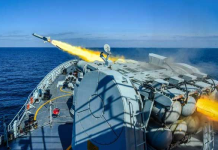By Lieutenant Colonel Khalid TaimurAkram (Retd), Executive Director, Center for Global & Strategic Studies (CGSS), Islamabad
The US presence, rhetoric and diplomacy concerning the Indo-Pacific region are of utmost importance. In the US Indo-Pacific Strategy Report (IPSR) released in 2019, the Indo-pacific region is referred to as a mega-region that spans between the west coast of the United States of America and the western coast of India. The concept has been part of the US strategic policymaking since 2017. Indo-Pacific alliance can be viewed as a practical manifestation of the Indo-Pacific Strategy of the United States of America, which highlights the geostrategic priorities of Washington in the Indo-Pacific region. The US Indo pacific Strategy can be viewed as an extension of the Obama administration’s pivot to Asia or Rebalance to Asia policy.
The Indian Ocean holds immense geostrategic, geo-economic, and geopolitical significance and has been a major point of struggle and interest for many states even in the past. The significance of the Indian Ocean can be measured through Mahan’s Theory of Sea Power that signifies the Indian Ocean utmost importance and maintains that “he who will rule these waters will rule the world”. The importance of the Indian Ocean Region for the three power claimants i.e. the US, China and India is evident through their growing involvement in the IOR.
To pursue its interests, the US has various basing facilities in the Indian Ocean along with the presence of the US Indo-Pacific Command (IPCOM) to serve its greater interests in the region. The US has advocated the development of the Indo-Pacific Economic Corridor to reaffirm the Free and Open Indo-Pacific (FOIP). Although the US is a resident and a sovereign power across the Pacific Ocean, its growing interest in the Indian Ocean cannot be denied and overlooked. The strategic interests of the US in the Indian Ocean region and its willingness to tackle shared challenges in the region have compelled Washington to rely more on its strategic proxies in the IOR that is predominantly India.
Indo Pacific Alliance
According to the National Security Strategy (NSS) of 2017 and the National Defense Strategy (NDS) of 2018, the US considers China as a strategic competitor and a revisionist power. Trump administration’s perspective about its increasing involvement in the Indo-pacific region together with its containment of China policy is an evidence that the US with India’s support is trying to enhance its influence in the region and is channelizing all its sources and potential alliances to counter China’s growing involvement in the India Ocean as well as its claim over the South China Sea, thus intensifying its Malacca Strait dilemma.
Indo Pacific Alliance being a practical manifestation of the Indo-Pacific Strategy of the US which is directedtowardscountering China’s rise and to revise the regional order would be the best option for the US to pursue these objectives. Through this alliance, the US is considering to further strengthen the already existing Quadrilateral Security Dialogue (QUAD) which consists of Japan, Australia, India, and the US which is an informal strategic formation with the sole purpose to counter China’s growing involvement in the Indian Ocean region which for many is the practical manifestation of China’s “String of Pearls” policy in the form its naval presence in Pakistan, Djibouti, Hambantota in Sri Lanka, the Maldives and many others.
The US is portraying itself as a beacon of peace and stability, merely to maintain its dominance in the Indo-Pacific region. To garner support, US is strengthening its cooperation with its traditional allies such as Australia, Japan, and South Korea, and is also promoting the Quadrilateral Security Dialogue with Japan, India, and Australia – its key allies in pursing the Indo Pacific Strategy. The US demands its allies India, Japan, and Australia to equally contribute in the pursuit of security and stability in the Indo-pacific region and to protect against US’ interests against what it perceives as the ‘common threat’ – China.
The US administration is now keen to implicitly exhibit China as a competitor. The Trump administration’s Indo-pacific policy can be viewed through the prism of US affirmation to endure economic and strategic stability in the in the region and for that, the US is pursuing active partnership and cooperative relations with its allies. To strengthen their efforts and to adopt a prolific policy to achieve their objectives all the partners are actively pursuing coordinated policies and strategies.
Not only the US, its allies are also seeking security assurances form the US so that in case of any aggression against them the US must extend support. Furthermore, together with the US support they are aimingto develop a joint combat force which will enable them to adopt credible deterrent posture against their adversaries.Practically, the US has already started the projection of its power in the Indian Ocean region as well as in the Pacific Ocean region predominantly in the South China Sea and in Taiwan Strait where the US is carrying out the Freedom of Navigation Operations (FONOPs), which involves various strategic allies of the US, especially India.
The major Allies and their stakes in the Indo-Pacific Region
The geographical context of the Indo-Pacific Alliance refers to the increased linkages between the littoral states of the Indian Ocean and the Pacific Ocean.China’s swift and enduring economic and strategic rise is a matter of concern for the potential alliance between India, US, Japan and Australia. Japan is an important strategic ally of the US in the Asia-Pacific region. For Japan this alliance will be the best opportunity to deal with its issues particularly with China over the Islands in the East China Sea and also to cater China’s growing economic and military potential in the Asia Pacific region.
India has always been a great supporter of US’ Indo-Pacific Strategy and the reason is well known. It interprets the idea of this alliance as a way to enhance maritimeinfluence. For India this alliance will provide ample opportunities to enhance its political, economic, and military cooperation with the United States of America and also to promote its economic and strategic interests in East and Southeast Asia. This will enable India to increase its influence in garnering the international support as well. Furthermore, linking withthe US Indo-Pacific Strategy, India is considering to complement its Act East policy, thereby, promoting its strategic goals withoutcompromising its strategic independence.
Australia’s willingness to join this Indo-Pacific alliance can be viewed in the context of enhanced trade linkages between the US and Australia. Australia though wants to increase its influence in South East Asia yet its main focus is to achieve economic benefits. While discussing the US Indo Pacific Strategy one cannot overlook the Potential of Southeast Asian countries which is a link between the Indian Ocean and the Pacific Ocean. Due to their geostrategic location, these countries will provide great support to the US to materialize its intentions vis a vis the Indo Pacific region. However, the ASEAN (Association of Southeast Asian Nations) countries are extremely cautious regarding the US ambitions especially when Trump has continued to show lack of interest in the ASEAN summit.
US Interests
The trajectory of the US policymaking pertaining to the Indo-Pacific region solidifies this claim that through this strategic alliance, the US is intending to enhance its dominance and also to serve its strategic interests in the region. The US withdrawal from the Trans-Pacific Partnership Agreement has also made it difficult to understand that what the US is aiming to do. However, the US has promised to invest approximately 113 million dollars to develop technology, energy and infrastructural sectors, which will be according to many international experts, conducive for promoting regional integration and development. If the US is successful in establishing its economic and strategic influence in the region, it will not be a good news for China, which is already having tensions with other regional countries over islands in East and South China Seas. Here China needs to adopt a vigilant policy to counter US strategic interests and increased involvement in the Indo-Pacific Region.
The US is also enhancing its security cooperation with Pacific countries like the UK, Canada, and France. Moreover, the US is continuously widening its engagement with India to improve its diplomatic, economic, and security relations. Having a common regional as well as Global competitor China is a major stimulating factor between the US and India in enhancing their cooperation. The US is aiming at offsetting the Chinese-led Belt and Road Initiative (BRI) to cater China’s growing involvement and influence in both the Indian Ocean as well as the Pacific Ocean region. The policymakers in Washington are focusing more on defaming BRI by Partnering with regional players, for instance, India, Japan, and South Korea to replace it. For instance, the Better Utilization of Investments Leading to Development (BUILD) Act President introduced by President Trump in 2018 is aiming at developing the US International Development Finance Corporation to invest in various developing countries in the Indo Pacific region, thus enhancing US presence in the region.
In the meanwhile, NATO’s sidelining policies vis a vis the US overextended military involvement though seems shocking for Pentagon, but realistically the US is already in a transitional phase where it is in the middle of its face-saving by planning its withdrawal from Afghanistan. Skeptics are of the view that through putting emphasis on this alliance, President Trump is making its position strong for the coming US presidential elections. For many, this will serve as a wild card for Trump to be reelected as the President of the US in the upcoming elections scheduled to be held in November this year.
The Indo Pacific Alliance: A threat to regional stability
The US Indo-Pacific strategy and the concept of Indo-Pacific alliance are purely China-centric. The US is using indirect approachessuch as trade wars, global supply chain disruptions, technology transfer blockages, diplomatic and military coercion, sanctions are few of the steps taken by the US to disrupt China’s global expansion. Yet the US does not seem to be successful so far. There are prospects that this alliance will disrupt the regional security and stability. The regional states will face a greater threat to their security and economic stability due to the power tussle between the existing hegemon the US and emerging economic power China. The power competition between these two superpowers has the potential to destabilize the regional peace and if both opted to go for the war then the consequences would be catastrophic and unbearable for the regional countries. So, it is important for the US to rethink its policy vis a vis Indo Pacific region because if the tensions between Beijing and Washington escalated it will definitely turn into a disastrous conflict that will have catastrophic implications for the regional stability in particular and world peace in general.

















